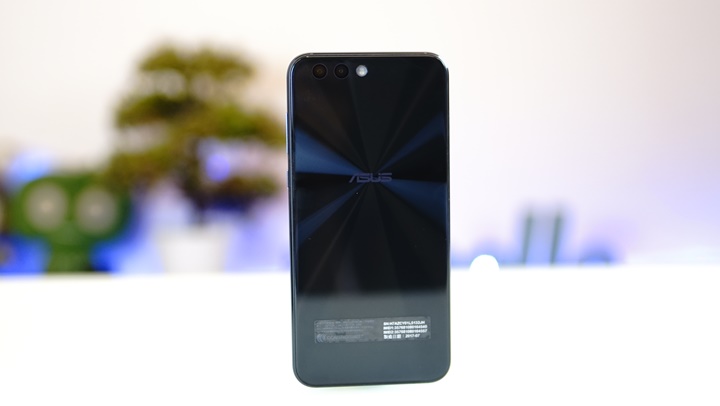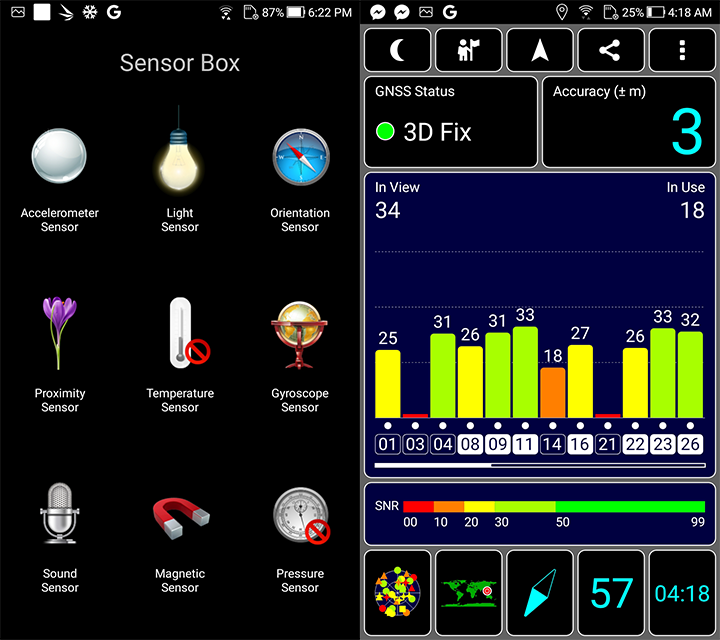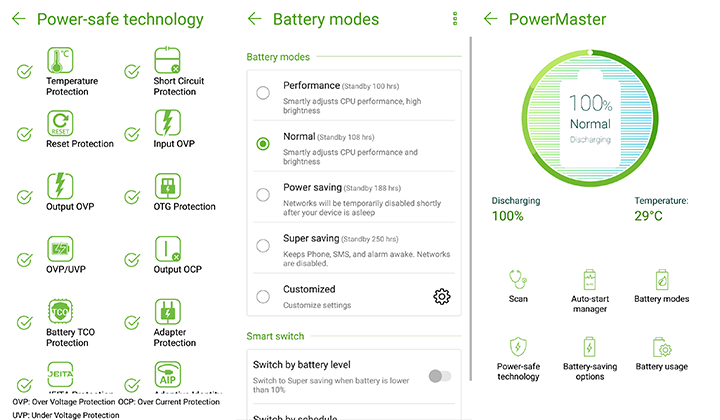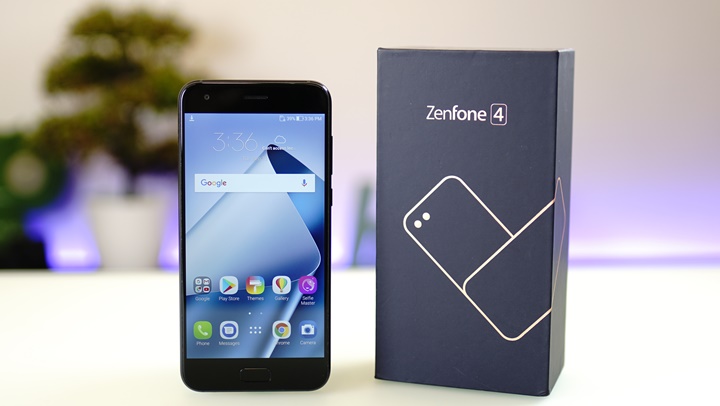The new Zenfone 4 lineup of smartphones from ASUS has definitely made waves as a set of devices that meet today’s standards, in different categories. Today we take a look at the titular character of the series, the mainstream flagship ASUS Zenfone 4. The particular configuration of the Zenfone 4 we’ll be taking a look at for this review packs a Snapdragon 660 8-core processor, Adreno 512 GPU, 6GB of RAM, and 64GB of storage. Let’s dive in.

Table of Contents
Right away, you’ll notice that the overall look and feel of the device is more premium, compared to the Zenfone 4 Max, Selfie, and Selfie Pro. It has an aluminum unibody design, and both the front and back are covered in 2.5D Corning Gorilla Glass. The phone is reasonably thin, but feels quite solid. From the moment I first picked it up, it felt much better in my hands than my LG G5.

The 5.5-inch Full HD Super IPS display up front is nicely accentuated by slim side bezels and is accompanied by the 8MP front camera and call speaker above, and the LED lit capacitive navigation buttons down below. The home button here also doubles as a fingerprint scanner.

Flip it on its back, and you’ll find the 12MP+8MP dual rear cameras, LED flash, and of course the ASUS logo. Unlike the rear of the Zenfone 4 Max, Selfie, and Selfie Pro, this one doesn’t have visible antenna bands. The back is actually my favorite part of the phone, as it just looks and feels so premium.

On the right side are the volume rocker and power button, while the left side houses the hybrid SIM tray.

Nothing much is up top, other than a noise-canceling microphone and a couple of antenna bands. Down at the bottom are a USB Type-C port, headphone jack, call microphone, and the speaker.

With its solid aluminum body, curved edges, and glass-covered front and back, the Zenfone 4 doesn’t just look good, it feels good to use. The rear especially though, is a fingerprint magnet, but ASUS also gives you a clear silicone soft case, just like with the Zenfone 4 Selfie.
Just like the Zenfone 4 Selfie Pro, this one packs a Super IPS display. The 5.5-inch screen has a resolution of 1920 x 1080 @ 401ppi, again, like the Selfie Pro. Unlike the lower-end 720p displays of the Zenfone 4 Max and Selfie, the Zenfone 4’s screen is crisp, has good contrast, and has nice colors. It isn’t however, quite bright enough to have a good outdoor use experience.

As for the audio department, the speaker can get really loud, but a middle to upper middle level of volume would be recommended, as it tends to lose some details in the highs and mids at maximum volume. Bass is lacking, too. All in all, the since the speaker is loud, it’s great for hands-free calls and casual listening, even with friends.
The device runs on Android 7.1.1 Nougat with ZenUI 4.0. If you’re fond of ZenUI, then you’ll like this improved version with less bloat and more responsiveness. It does look quite cartoonish at a certain point, but it still does look pretty clean.

Pre-installed apps aren’t that plentiful which is good and includes Facebook, Messenger, Instagram, the Google suite of apps, and some proprietary ASUS apps. Notable ASUS apps are Selfie Master, which features ASUS’ beauty mode for photos, videos, and live streams, and Mobile Manager for device monitoring and optimization.

Out of the 64GB of total storage, 51.64GB is usable out of the box. If that’s still not enough, you can further expand this via microSD.
The Zenfone 4 sports 12MP+8MP dual rear cameras and an 8MP front camera. The main 12MP rear shooter has a Sony IMX362 sensor and has an aperture of f/1.8, and a field of view of 83-degrees. It features 4-axis OIS, PDAF, and a six-element lens. Meanwhile, the 8MP secondary shooter has a wide field of view of 120-degrees, and the 8MP front camera has an aperture of f/2.0.

There are a few modes available to you through ASUS PixelMaster, including a manual mode with a very wide shutter speed range of 1/10000s to 32s and a wide ISO range of 25 to 3200. Other modes are Portrait, which like the other Zenfone 4 variants, artificially blurs the background, Super Resolution mode, which gives you a photo with a resolution of 8064 x 4544, and Beauty Mode for removing blemishes on your subject’s face. You also get nine filters if you want to spice up your image a little bit.


The device features a Qualcomm Spectra 160 image signal processor which gives faster autofocus and clear photos with good color. Resulting photos are, in fact, clear, have good color, though dynamic range isn’t that good even with HDR mode turned on. Photos also get quite grainy in low-light situations despite the large aperture.
The main 12MP rear camera definitely outshines the secondary, which is quite expected. The difference is not by a lot, as you can still get some really nice landscapes and such with the secondary camera, but the change in quality is definitely there. The front camera, on the other hand, is definitely better suited for well-lit environments, though it definitely doesn’t capture as much details as other smartphones with better front cameras do.
The Zenfone 4 comes in Snapdragon 630/Adreno 508/4GB RAM and Snapdragon 660/Adreno 512/6GB RAM flavors. As mentioned earlier, the one we’re using for this review is the latter. Our experience in gaming was a smooth one thanks to the 30% performance increase of the new chipset over its predecessor. Thanks to its large RAM capacity, multitasking and long periods of usage was excellently handled by the device.

The scores we got on our synthetic benchmarks were pretty good.
Basic connectivity features are covered here, which includes WiFi, LTE, Bluetooth, GPS, and NFC. Call quality and mobile data usage both work as advertised, as long as you have good coverage. Even in the deepest parts of the Metro, GPS location services will not fail you when using navigation apps like Google Maps and GPS.

Giving juice to the Zenfone 4 is a 3,300mAh battery, which actually holds its own pretty well, thanks in part to the more efficient Snapdragon 660.

The device does support fast charging through ASUS BoostMaster, and at a starting point of 0%, you can expect to reach full charge within 1 hour and 30 minutes. In our usual video loop test, the phone lasted a solid 13 hours and 30 minutes of continuous playback. In moderate to heavy real-world use, the Zenfone 4 can easily last you more than a day on a single full charge.
ASUS certainly did not let down with their mainstream flagship device, the titular character of the Zenfone 4 lineup. With its premium and classy design, up to date internals, Super IPS display, and good camera performance, the ASUS Zenfone 4 is certainly worthy of representing an entire series of smartphones.

The ASUS Zenfone 4 has a suggested retail price of Php28,995USD 494INR 41,886EUR 471CNY 3,598 and is available at ASUS concept stores.
ASUS Zenfone 4 (SD660) specs:
5.5-inch Super IPS display @ 1080 x 1920 pixels (401ppi)
Corning Gorilla Glass
64-bit Qualcomm Snapdragon 660
Adreno 512
6GB RAM
64GB internal storage
Expandable up to 2TB via microSD (uses SIM 2 slot)
12 MP f/1.8 Sony IMX362+ 8MP wide angle dual rear cameras: OIS 4-axis, Dual Pixel PDAF with dual-LED flash
8MP f/2.0 front camera
Dual-SIM (nano)
4G LTE
Wi-Fi 802.11 a/b/g/n/ac
Bluetooth 5.0
NFC
GPS, AGPS, GLONASS, BDS
Fingerprint scanner
USB Type-C
ASUS ZenUI 4.0 (Android 7.0 Nougat)
3300mAh non-removable battery
155.2 x 75.2 x 7.5 mm
165 g
Moonlight White, Mint Green, Star Black
What we liked about it:
What we did not like:

YugaTech.com is the largest and longest-running technology site in the Philippines. Originally established in October 2002, the site was transformed into a full-fledged technology platform in 2005.
How to transfer, withdraw money from PayPal to GCash
Prices of Starlink satellite in the Philippines
Install Google GBox to Huawei smartphones
Pag-IBIG MP2 online application
How to check PhilHealth contributions online
How to find your SIM card serial number
Globe, PLDT, Converge, Sky: Unli fiber internet plans compared
10 biggest games in the Google Play Store
LTO periodic medical exam for 10-year licenses
Netflix codes to unlock hidden TV shows, movies
Apple, Asus, Cherry Mobile, Huawei, LG, Nokia, Oppo, Samsung, Sony, Vivo, Xiaomi, Lenovo, Infinix Mobile, Pocophone, Honor, iPhone, OnePlus, Tecno, Realme, HTC, Gionee, Kata, IQ00, Redmi, Razer, CloudFone, Motorola, Panasonic, TCL, Wiko
Best Android smartphones between PHP 20,000 - 25,000
Smartphones under PHP 10,000 in the Philippines
Smartphones under PHP 12K Philippines
Best smartphones for kids under PHP 7,000
Smartphones under PHP 15,000 in the Philippines
Best Android smartphones between PHP 15,000 - 20,000
Smartphones under PHP 20,000 in the Philippines
Most affordable 5G phones in the Philippines under PHP 20K
5G smartphones in the Philippines under PHP 16K
Smartphone pricelist Philippines 2024
Smartphone pricelist Philippines 2023
Smartphone pricelist Philippines 2022
Smartphone pricelist Philippines 2021
Smartphone pricelist Philippines 2020
WilliamC says:
Is it really AMOLED? Asus websites states that it is Super-IPS. I think only the Pro (as well as the Selfie Pro) version utilizes AMOLED.
Easy E says:
Get the LGG6 at this price.
Sorry ASUS, next year nalang ulit. Sobrang mahal naman kasi.
A Seuss says:
Yes, it’s expensive but still way better than O*PO F3 Plus which has outdated chip but still as expensive as this